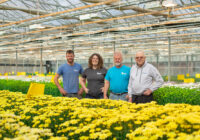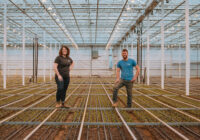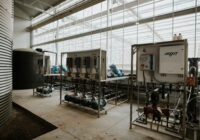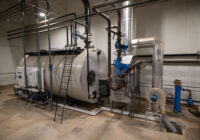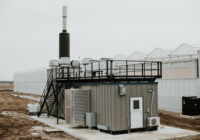
Features
Flowers
Grower Profiles
Management
Structures & Equipment
Succession in bloom
Cut flower grower tackles both succession and expansion head on.
May 12, 2022 By Greta Chiu
 Three generations of owners stand side-by-side at John Slaman Greenhouses. From left to right: Theo, Stephanie, Brian and John Slaman. photo courtesy of Tia Slaman
Three generations of owners stand side-by-side at John Slaman Greenhouses. From left to right: Theo, Stephanie, Brian and John Slaman. photo courtesy of Tia Slaman Succession can be a touchy subject for many farm families, but the Slamans have found a way to tackle the process, all while building a brand new greenhouse facility.
Retiring from the family farm isn’t the same as retiring from a company, says Stephanie Slaman. “In our case, there is a family home on the farm. Not to mention eight siblings that need to be considered. What does that look like when the transition occurs?”
Last year, she and her brother Theo become part-owners of John Slaman Greenhouses in Burford, Ont. They share the responsibility with their dad, Brian, who had been the sole proprietor for almost a decade prior. It’s part of a 10-year transition process which began three years ago. Brian initiated the conversation with his partner Judi and eight children about his future plans and expectations. “This allowed the family and business considerations to be openly discussed in a transparent way, supporting individual and collective concerns,” says Stephanie. Once Theo and Stephanie received collective support from their siblings on taking active roles in the business’ ownership, the legalities moved forward.
“There’s still a lot of knowledge and guidance that Theo and I will rely heavily on my dad for,” Stephanie says. In fact, their grandfather and founder of the company, John Slaman, still actively visits the site every day. “My grandfather and I have fantastic conversations about all aspects of both our company and the industry,” she says.
Stephanie and Theo are the third generation to manage the cut flower operation. John Slaman built the first 18,000 sq. ft. in 1969 for chrysanthemums, which eventually grew to 63,000 sq. ft. In 1987, his sons, Brian and Mike succeeded the operation and built 37,000 sq. ft before expanding by an additional 45,000 sq. ft. to accommodate their new crop, lisianthus. In 2012, Brian became the sole owner of the greenhouse operation. His children, Stephanie and Theo would join him as part-owners almost a decade later.
There weren’t many management-track opportunities for quite a long time, says Stephanie, who went on to pursue a professional career in economic development in B.C. But even on the other side of the country, she found herself drawn to the local flower auction and sometimes walking into a florist shop just to ask if she could stand inside their cooler. “It smelled so uniquely like home,” she says, reminiscing. “That’s where I figured out that this passion for the agriculture industry… isn’t ever going away.”
Meanwhile, Theo had chosen a career in construction, developing his professional skills in leading residential and commercial projects. Three years later, he returned to the greenhouse, working with the plants and learning the ropes before taking over management of their lisianthus crop in 2017.
When the family’s focus eventually shifted towards their business’ future, Brian, now in his early 60s, knew it was time for a discussion.
A partnership made sense. All three brought complementary skills to the table, forming a formidable team: Stephanie’s experience in administration and governmental relations, Theo’s skills in construction management and aptitude for operations, and Brian’s ability to manage staff, production and customer relations.
“We all talked about the goals of the company, future opportunities, the current needs and our personal aspirations within the company,” says Stephanie. And they were honest about it with each other.
“My partner and I packed up our life, then drove across the country in the dead of winter and in a pandemic,” she says of her trip back to Ontario with her spouse. Realizing that the operation would not be able to support three full-time management positions, Stephanie found full-time employment at the City of Guelph and instead, spends evenings and weekends on greenhouse tasks. “That’s part of the [succession] conversation, too. If my dad is still running the company full-time and my brother is on the ground at the greenhouse every day, how do you look at the succession plan in that context? How are we making space for those strategic conversations …that value [everybody’s] work?”
Theo emphasizes the importance of mutual understanding. “We understand what our different skillsets are, and we’re willing to reach out to each other for help,” he says. That’s been a critical part to their working relationship as they continue the succession process and plan for the future of the operation.
Stephanie agrees. “There were a lot of decisions that we made together, but for those that were made independently, it was important to know we had each others’ backs. It was essential to us that additional management did not complicate the efficient operations and that we all agreed on the strategic direction.”
The world has certainly thrown them a few curveballs, but by supporting each other every step of the way, the dynamic trio took it all in stride. Faced with COVID-induced supply chain issues as well as delays in local, bureaucratic processes, the team broke ground on the new greenhouse last July, then planted their first crop in February of this year. Although they missed some milestones, the team has been pushing for Mother’s Day, which is a key market holiday for both lisianthus and chrysanthemum.
“For the first generation on a farm, everything is new,” says Theo, recalling an article he had read. “It’s the third generation who typically needs to rebuild or create new infrastructure, as well as reach out to new customers as previous ones may be retiring or turning over.”
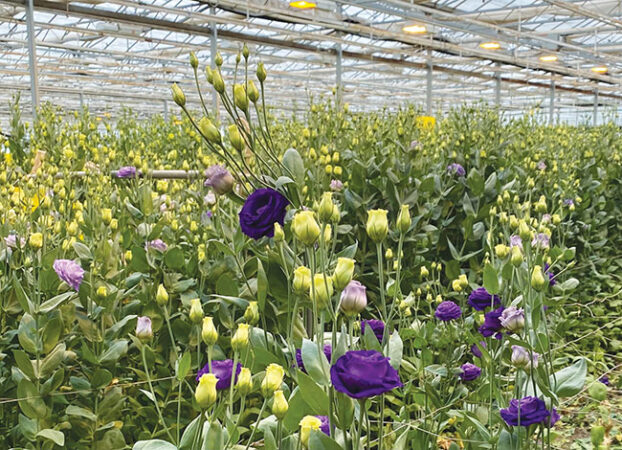
Anticipating the new build, the Slaman team made significant retrofits to the older facility over the last few years. photoS courtesy of Tia Slaman
A walk through history
Anticipating a new build, the Slamans made significant and intentional retrofits to their original, older facility over the last few years. “We want to ensure that there’s no difference in our product lines [whether] it’s being grown in the most recently built zones of our greenhouse to the most historic areas,” says Stephanie. “There are three components that we agreed were driving our business – labour efficiencies, energy and water sustainability, and technology adoption/innovation.”
The original facility also produced its last lisianthus crop this year. It’s now dedicated to two types of chrysanthemum production.
The first is what Stephanie calls the commercial look, where a single large bloom sits at the very top of the stem. “For this one, we take off all of the little side buds and all of the energy from the plant is directed to the top.”
The second is the spray look where there are multiple blooms per stem. To achieve this, the team pinches off the top to encourage side buds to bloom in sync.
On average, it takes about 10 to 12 weeks to produce each chrysanthemum crop, allowing four to five rotations per year. They push for a bit more crop to meet periods of higher demand, such as Valentine’s Day or Mother’s Day. All in all, they plant and harvest continuously and steadily, year-round. “We may do an additional third [of the crop] and plan a lull behind it,” she says.
In this facility, almost every task is still done by hand, from the steaming of the soil to the harvest and sleeving of their cuts.
Growing different varietals of the same genetics, the team conducts their own selective breeding in-house to pick and choose their preferred attributes. Cuttings taken from the mother plants are stuck by hand, then spend two weeks in the propagation area before being transplanted into growing beds.
Walking through this greenhouse facility is like taking a trip through time. The growing zones become progressively taller, more automated, and differed in structural appearance.
Many retrofits had been done over the years, Theo points out. For one, they used to rely on a manual crank to close the windows, rushing back to the greenhouse whenever it rained. Now, they can control the ventilation through their Argus system and from their mobile phones, all while monitoring the other variables in the greenhouse.
“One of the other recent upgrades was the lighting,” Theo says. Previously, production simply depended on the sun. “There are enough lumens in the sunlight to grow. [The crops] just take longer or … have more variability. In the summer, we would use shade screens [to lower] the intensity of the sun. And in the winter we need to add artificial lighting.”
As the greenhouse acquired more lighting and automation, their electricity needs also rose. Five years ago, they decided to install a combined heat and power generator powered by natural gas which produces electricity for the farm. The waste heat, a byproduct of the process, is used to heat the greenhouse. It took about four years to pay off the investment, and the change reduced their electricity costs by 80 per cent.
There is a huge opportunity for Canadian-made greenhouse solutions in the climate controlled agriculture sector. “Even with the innovation and investment that is happening, we’re still behind European leaders in The Netherlands,” Brian shares. “This has always been the case, but we’re focused on the future opportunities for our business and these investments have positioned the company well.”
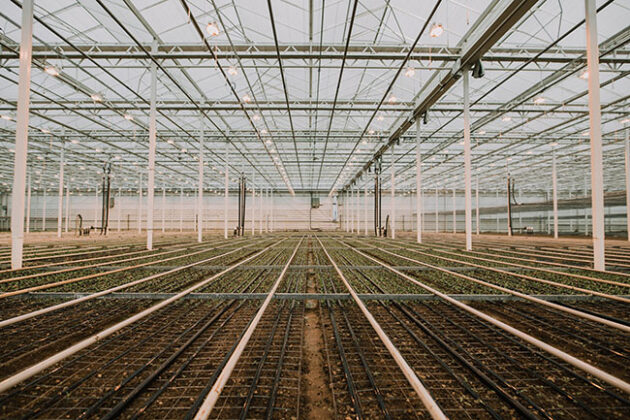
In early 2022, Slaman’s planted their first crop of lisianthus in the new greenhouse. photoS courtesy of Tia Slaman
Built for expansion
Located just five minutes away is Slaman’s new 150,000 sq. ft. facility. The space is dedicated to lisianthus production, which takes about 12 to 14 weeks to complete. Although the area is roughly equal in size to their first greenhouse, the new facility was built for expansion and efficiency.
There were a number of key reasons that propelled them towards a new, separate site, despite the 45,000 sq. ft. of available room behind their original facility.
Lisianthus is very susceptible to fusarium, explains Theo. The crop also has a long taproot that pushes deep into the ground, making it imperative to steam sterilize deep into the soil. Unfortunately, the available lot behind the older facility had a tremendous amount of pitrun material underneath, which does not allow them to sterilize deep enough. “We knew we couldn’t expand there with lisianthus.”
Other reasons had to do with the existing infrastructure of their original facility, which would not have been able to sustain much more production. Plus, using up the available lot would have left them landlocked and unable to expand in the future.
“Now we’re on a farm with 150,000 sq. ft. of greenhouse and 40 acres of wide open field,” says Theo. There’s plenty of room to expand on each side, allowing them to add more houses or widen each one. It’s rife with opportunity.
But the biggest difference between the two greenhouses comes down to operational efficiency.
Where the older facility used raised benches that required manual adjustment, the new facility takes advantage of large area automation. The roof is about 30 per cent taller, which allows room for more efficient mechanized systems and contributes to a more stable growing environment. There is also about 30 per cent more lighting output along with sensors throughout, per square foot.
To tackle the issue of fusarium, they’ve installed underground suction lines that pull the steam further into the soil. “That helps to steam deeper, more thoroughly and in less time,” Theo says.
Currently, the new greenhouse is able to produce up to four times more product each week than their original farm.
Looking ahead, Theo says they’ve laid the foundations for a cost-effective expansion in the future, such as the 8,400 sq. ft. cooler and the 350-horsepower boiler. “It may have added roughly 20 per cent to our initial build costs to install additional (or larger) infrastructure,” Theo estimates. However, the costs weren’t high enough to necessitate an immediate expansion just to recoup the costs, leaving them with some flexibility.
Although the Slamans continue to make upgrades to the older greenhouse, the new facility could also house chrysanthemums one day. “We still have a facility that is competitive right now,” says Theo, “but in 10 or 15 years? It may not be.”
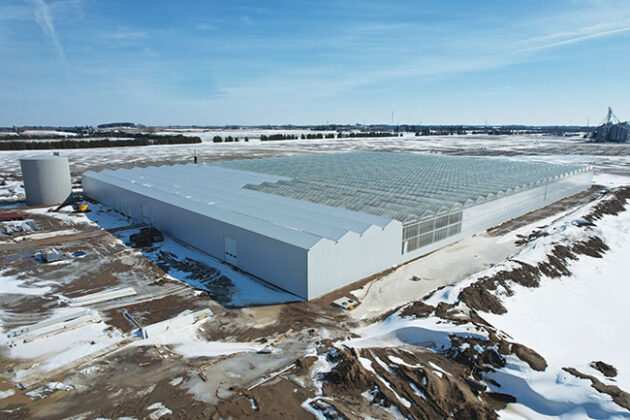
The new 150,000 sq. ft. facility has plenty of real estate left on each side to accommodate future expansions. photo courtesy of Gary Foster
Market outlook
A strong, growing market is what led Slaman’s to double their production space. “Floral consumers are more sophisticated and interested in knowing products are grown locally utilizing sustainable practices,” says Stephanie. “[We are] investing to meet this demand. It aligns with [our] company values of bringing premium quality floral products to market.”
People are starting to recognize lisianthus, but may not yet know it by name. “The consumer is still learning about [it]. We’ve seen it grow very strongly in Europe over the last 10 years,” she adds.
Currently, about 35 to 40 per cent of Slaman’s products go to the Dutch-style floral auctions – Ontario Flower Growers in Mississauga, Ont. and Marché Florale in Montreal, Que. The rest predominantly sell direct to floral wholesalers, distributors and retailers.
“You need to get more product out there for consumers to learn about it,” says Theo, but adds that it’s important not to produce too much. “Flowers are different, especially in Canada.” Recalling previous trips to The Netherlands, he’s seen cut flowers on the tables of fast food restaurants as well as visited cut flower growers with operations 10 times the size of theirs, all growing lisianthus. “In Canada, we don’t have the same cultural floral ties [as the Dutch] so the market is smaller.”
“On the way home, they’re picking up a fresh bouquet for the house,” adds Stephanie. “You’re not just getting it for a special holiday or birthday.” COVID-19 may have changed that for some Canadian consumers. “The wellness benefits of sending a bouquet to a friend or family member to brighten their day has become more apparent in conversations with friends. I know those in the industry are talking about it and looking to realize the opportunity this new consumer awareness brings.”
When asked about expanding to other cut flower crops, Theo says they have no immediate plans to do so, but it all depends on the market.
“We’re good at what we do and we’ve been doing it for a long time,” he says. “We are going to keep doing it until consumer trends change. It’s about what’s best for the crop, our customers and long-term success.”
Print this page
